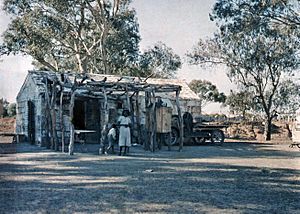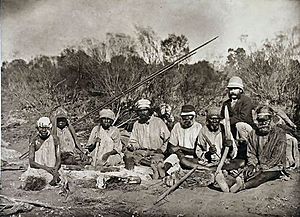Paakantyi facts for kids
Quick facts for kids Paakantyi LandsNew South Wales |
|
|---|---|
The Paakantyi people, also known as Barkindji, are an Aboriginal Australian group. They traditionally lived along the Darling River in Far West New South Wales, Australia. They call the Darling River the Baaka.
Contents
Understanding the Paakantyi Name
The name Paakantyi means "River people." It comes from the word paaka, which means river, and the ending -ntyi, meaning "belonging to." So, Paakantyi simply means "people who belong to the river." They also call themselves wimpatjas.
Paakantyi Language
The Paakantyi people traditionally speak the Paakantyi language. This language is part of the Pama–Nyungan language family. It is one of the main Aboriginal languages spoken in the Broken Hill region today.
A linguist named Luise Hercus did important work studying the Paakantyi language.
Paakantyi Country and Land
The Paakantyi people lived along the Darling River. Their land stretched from Wilcannia almost to Avoca. Their territory also went inland about 20–30 miles from both sides of the river.
They also lived in the areas away from the river, near the Paroo River and Broken Hill. Their land was about 7,500 square miles (19,425 square kilometers). The landscape often has red sandhills and flat grey clay areas.
Today, the Barkindji people come from several different groups who spoke slightly different versions of the same language. These groups include:
- Baarundji
- Wilyakali
- Pulakali
- Pantjikali
- Wanyuparlku
- Barkindji
- Thankakali
- Marawara
Even though the land could be very dry, the Paakantyi knew how to survive. During droughts, they would move to areas with permanent springs. They would hunt animals that came to these springs for water.
Paakantyi Stories and Beliefs
In Paakantyi stories, the land and river were created by Ngatji. This is the Dreamtime rainbow serpent. The Paakantyi believe that Ngatji still travels underground between waterholes. They believe Ngatji should not be disturbed.
You can see Ngatji's presence when strong winds stir up the water in the Darling River.
History of Contact with Europeans
The first European explorer to travel through Paakantyi land was Thomas Mitchell. He likely met the Barkindji people near Wilcannia.
Before Europeans arrived, the Paakantyi population was quite large. However, European settlement had a big impact on their lives. Many people became sick and sadly passed away. This happened even though they had enough food and clothing.
In the 1850s, a serious illness affected the Paakantyi and a nearby group called the Naualko. It caused many deaths, about one-third of each group. People fled to the Paroo River to escape the illness.
Frederic Bonney was one of the first settlers in their area. He lived there for 15 years, starting in the mid-1860s. Bonney took many pictures of the Paakantyi people. He wrote that they were "naturally honest, truthful, and kind-hearted." He also said they were "very kind" to children and "affectionate and faithful" to friends.
As their traditional ways of life changed, the Paakantyi people faced new challenges. Today, many Paakantyi descendants live in Wilcannia. About 68% of Wilcannia's 600 residents are of Paakantyi descent.
Wilcannia was once a busy river port. However, too much grazing by cattle and sheep, along with rabbits and droughts, damaged the land. New types of fish in the river also harmed its natural balance. More recently, taking water from the Darling River for farming has greatly reduced the water flow. This has affected the "people of the river" who depend on it.
Native Title Recognition
In 1997, the Barkindji people began a legal process to claim native title over their traditional lands. They gathered many documents and reports from elders, anthropologists, historians, and language experts to support their claim.
After 18 years, their native title was officially recognized by the Australian government in 2015. This ruling by federal judge Jayne Jagot means they have legal rights to their traditional lands. The area covers about 128,000 square kilometers (49,421 square miles). It stretches from the South Australian border to Tilpa, south to Wentworth, and north to Wanaaring.
Other Names for Paakantyi
- Bakanji, Bakandi,Bakanji, Bakandi, Bargunji, Bagundji, Bagandji
- Bandjangali
- Bargunji, Bagundji, Bagandji
- Barkinji, Barkinjee, Barkunjee, Bahkunji
- Bpaa'gkon-jee
- Kaiela (A Kureinji term for them, meaning "northerners")
- Kkengee
- Kornoo (A name for the language of several Darling River tribes)
- Kurnu
- Pakindji, Pa:kindzi, Bakandji, Bahkunjy, Barkinghi
- Parkungi, Parkengee, Parkingee, Parkingee
- Wimbaja ("man")
Some Paakantyi Words
- kuuya (a general word for fish)
- mingga (waterhole)
- parntu (cod fish)
Notable Paakantyi People
- Elsie Rose Jones, a respected elder and teacher (1917–1996)
- Annie Moysey, a community leader, known as "Grannie Moysey" (1875-1976)
- Panga, an artist from the 1870s
- Dick Barkinji (explorer)
- Derek Eggmolesse-Smith, a footballer
- Barkaa, a musician
Books About the Paakantyi
- Kilampa wura Kaani: The galah and the frill neck lizard, told by Elsie Jones, illustrated by Cecil Whyman. Wilcannia, N.S.W.: Disadvantaged Country Area Programme, 1978
- Paakantji Alphabet Book, by Elsie Jones, illustrated by Mark Quale and Tim Whyman. Dubbo: Disadvantaged Country Area Programme, Western Readers Committee, 1981.
- The Story of the Falling Star, told by Elsie Jones, with drawings by Doug Jones and collages by Karin Donaldson. Canberra: Aboriginal Studies Press, for the Australian Institute of Aboriginal Studies, 1989.




